So I have not updated this blog in a while, for a few reasons really. Firstly, I haven't been taking many photos since I've been so busy. Second, I've been busy because I've graduated, moved away from Lansing to the Detroit area, and begun looking for a job.
Basically, this leads me to the realization that using such a location-specific URL was probably not a great idea. I'll be deciding on a new name sometime and probably move everything to the new URL. Or maybe just start with a clean slate.
Anyway, my last few days in Lansing were quite interesting from a cyclist's point of view. My wife and I went on our first multi-day bike tour, from Lansing to Seault Ste. Marie*, known to locals as the DALMAC. DALMAC is a sag-supported tour, where you pedal about 60-100 miles a day, set up camp at a high school at a small town, and the volunteers bring along your gear in a UHaul. If you break down terribly they'll help you out and maybe give you a lift to the next stop, but beyond that you're on your own pretty much, as we would find out.
Day 1 was nice, flat, and a good pace. We rode on pretty familiar roads much of the day, and aside from the odd dairy farm and beef farm not much was out there to look at. We set up our tents as it began to drizzle, ate some cafeteria food, and played some cards with the friends we were lucky enough to have with us. Holly's 650b tires showed some cuts, which taught me two lessons: 1, bring a spare if you're rolling on odd-sized tires, and 2, make sure your tires are in good condition BEFORE you're 70 miles from home!
Day 2 was similar, but brought with it some nasty rain showers about 12 miles from camp. We put the hammer down and arrived in camp only to realize the place where the crew had unloaded our gear was now a lake. Lesson: pack your gear in waterproof bags, or in ziplocks within the luggage. So we found a laundromat before closing time, dried out our sleeping bags and clothes, and had a beer or three.
Day 3 was rainy on and off, but the scenery was starting to get more interesting, with pretty rolling hills, pine forests, and friendly people selling pie at a church. A few heavier storms put a bit of a damper on things (har), but in all it wasn't so bad, and we had the opportunity to head over to Short's brewery at Bellaire, Michigan. We'd highly recommend the side trip if you can, as the brewery will be the best food and easily the best beer you'll have all trip. Also, the food at camp was truly awful here. The night fell, and brought with it 50 mph winds and heavy all-night rains. Lesson: Bring rain gear and cold weather gear. Even if you don't use it, it's good to have. You can always pack less warm weather gear and get by, but missing cold and rainy gear sucks when you need it.
Day 4 sucked. No way around it. Heavy winds, biggest hills of the ride, cold, and downpours for all but 10 miles of the day. We started out with about half of the riders who began the tour already having bailed. We would have bailed too at this point if it were an option, but we were up north with nobody to pick us up within hundreds of miles. 14 miles in, after struggling up and braking down difficult hills during the worst rain yet, we flagged down a SAG wagon to see if they'd give us a ride past the hills. No dice said the crew, so we soldiered on until catching up with our friends at a little breakfast spot. We waited through the worst weather while enjoying a hot coffee and warm cinnamon bun.
Heading back out again, it began to look a little nicer (raining on and off instead of constantly), and once we hit Boyne City the sun was downright beaming. At this point our silly crew was actually thinking of going for the century option for the day instead of the 65 mile route. We watched the whitecaps break on the bay as we rolled through town, enjoying the beautiful view. It would be our last fun moment of the day. As we broke north towards Pellston, with about half the day's mileage behind us, the Gods once again showed their anger, gusting winds and stinging rain. In the worst of the weather, we stopped at a McDonalds for respite and food. When the weather continued to worsen, we headed back out to be greeted by a wave of water as we pulled out of the driveway, courtesy of a passing SUV. The roads chosen for this section were the busiest with the worst shoulders of the trip, and combined with the limited visibility I really began to worry for our safety. Lesson: bring along a spare rear blinky light in case. The Superflash in particular seems susceptible to rain-related shorting out, and mine was useless after a couple days of this weather. Also lots of chain lube helps when it rains for 4 straight days.
Eventually we hit the last few miles. I was delirious by this point, egging on fellow riders by conversing, joking, singing aloud, anything I could do to not allow the rain to break me (or had I already broken?) A passerby said "I don't think the heavy stuff's gonna come down for quite a while," to which my Caddyshack-loving wife replied "I'd keep playing." And of course "Rat Farts!" upon reaching the top of the hill. A few miles later I had good reason to proclaim "rat farts" myself, as a shard of glass had worn its way through the casing of my tire, causing a horrible gash. Just like that, my day was over, about 1.5 miles from camp. My wife and I decided to bail out from the last day as the forecast was another rainy day, with winds that would probably prevent a bridge crossing. The last day, the only one we weren't riding, was gorgeous by the way, if anyone was wondering whether we were the jinx.
So would I do DALMAC again? Even if it was guaranteed nice weather, maybe not. I'd do another tour certainly, but honestly DALMAC wasn't really up our alley. Most of the riders are older men who seem to enjoy riding quite a bit faster than we do, and take the ride more seriously than we do in some ways. You certainly need to go with friends, as hanging out at the end of a long ride makes things go a lot better. I'm thinking the easy-riding, hard-partying souls on RAGBRAI might be more our speed.
Friday, October 1, 2010
Wednesday, July 14, 2010
Buildin' Bikes
I'm building up quite a few bikes just as I'm ending my tenure as a bike shop employee. I'm through two right now and on to the third, and all of them have my stamp on them for sure - steel-framed bikes that ride fast and smooth, and look clean.
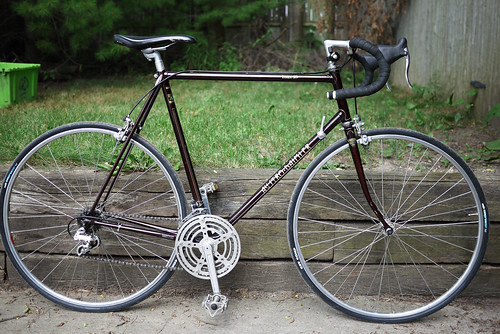
First up is an Austro-Daimler bike that my Dad had given to him mostly intact. This bike basically needed only tires, tubes, cables, and bar tape. I also added on a set of aero brake levers as the originals had long ago stopped functioning well, and also a new saddle to cushion Dad's old butt. I wanted to put some nice 700x28 tires on it to smooth out the ride even more, but the 700x25 was as wide as I had ready access to.

The Austro-Daimler Inter-10 is an interesting bike. Austro-Daimler is the US brand name for Puch before they decided A-D wasn't such an awesome name. Made in Austria from butted Reynolds 531, this bike is actually at the bottom of A-D's offerings, which just amazes me. At 23 pounds, it's pretty darn light for a large steel bike from the seventies. It came with a mix of Suntour Cyclone and Huret shifters and derailers, a Nervex crankset, Atom hubs and Rigida rims, all of which is very nice stuff! Thankfully the bottom bracket is in good shape as I'd hate to try to find out what threading it has. It's a fast bike, and well above my Dad's current skill and fitness level, so it's something he can grow into if he wants. It's too big for me, so I won't be keeping it.

My wife's bike is something I've shown before, an '80s Wisconsin-built Trek 560, built originally for road racing but adapted by me with 650b wheels and fast cushy tires for longer tours. She'll be riding it on this year's DALMAC from Lansing to Seault Ste. Marie. I finally got rid of the old Schwinn steel wheels I used for the conversion at first, replacing them with a 105 set from Velo Orange. If you haven't seen their high-polished aluminum rims in person, it's a sight to behold. Another mechanic in the shop today was convinced they were chromed steel from the shine. Actually many of their bike bits are just great in terms of aesthetics and value, and they make many things that nobody else has, from French bottom brackets and headsets to a new T-A copy crank that I'll have a hard time resisting.
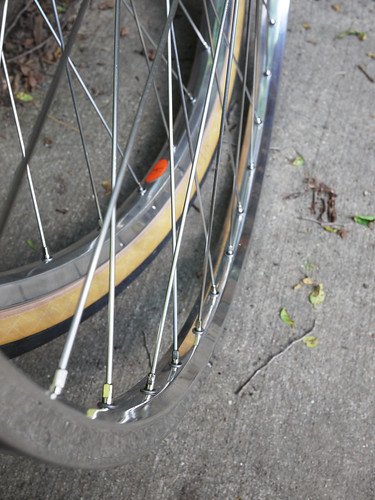
I added on older 8-speed Dura-Ace shifters, a Campagnolo front Derailer and modern Shimano rear, none of which should work together and yet does, amazingly. Because she has long legs and a shorter torso than most riders, she needs a funky stem setup (tall rise and short reach) to get comfortable on these frames, which means that someday she'll probably need a custom frame to fit her correctly. Maybe a Sweetpea.
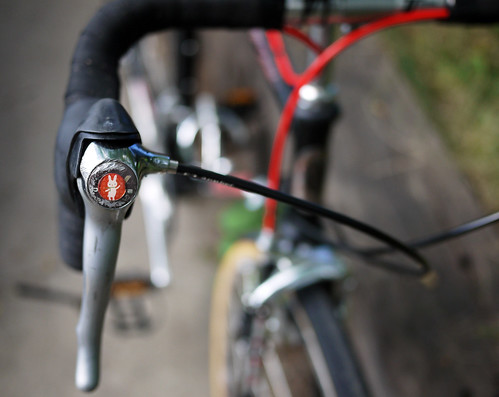
The final bike is an old Peugeot Mixte that needs a bit of work. No photos of that one yet! I have two other friends I want to build up bikes for, but no donor frames yet. Unfortunately this is more a labor of love than a money-making scheme, as bike parts are too expensive to really make any money doing this the right way; I figure I'm happier building bikes I like for people I love, than building crappy bikes by cutting corners to try to make a buck.

First up is an Austro-Daimler bike that my Dad had given to him mostly intact. This bike basically needed only tires, tubes, cables, and bar tape. I also added on a set of aero brake levers as the originals had long ago stopped functioning well, and also a new saddle to cushion Dad's old butt. I wanted to put some nice 700x28 tires on it to smooth out the ride even more, but the 700x25 was as wide as I had ready access to.

The Austro-Daimler Inter-10 is an interesting bike. Austro-Daimler is the US brand name for Puch before they decided A-D wasn't such an awesome name. Made in Austria from butted Reynolds 531, this bike is actually at the bottom of A-D's offerings, which just amazes me. At 23 pounds, it's pretty darn light for a large steel bike from the seventies. It came with a mix of Suntour Cyclone and Huret shifters and derailers, a Nervex crankset, Atom hubs and Rigida rims, all of which is very nice stuff! Thankfully the bottom bracket is in good shape as I'd hate to try to find out what threading it has. It's a fast bike, and well above my Dad's current skill and fitness level, so it's something he can grow into if he wants. It's too big for me, so I won't be keeping it.

My wife's bike is something I've shown before, an '80s Wisconsin-built Trek 560, built originally for road racing but adapted by me with 650b wheels and fast cushy tires for longer tours. She'll be riding it on this year's DALMAC from Lansing to Seault Ste. Marie. I finally got rid of the old Schwinn steel wheels I used for the conversion at first, replacing them with a 105 set from Velo Orange. If you haven't seen their high-polished aluminum rims in person, it's a sight to behold. Another mechanic in the shop today was convinced they were chromed steel from the shine. Actually many of their bike bits are just great in terms of aesthetics and value, and they make many things that nobody else has, from French bottom brackets and headsets to a new T-A copy crank that I'll have a hard time resisting.

I added on older 8-speed Dura-Ace shifters, a Campagnolo front Derailer and modern Shimano rear, none of which should work together and yet does, amazingly. Because she has long legs and a shorter torso than most riders, she needs a funky stem setup (tall rise and short reach) to get comfortable on these frames, which means that someday she'll probably need a custom frame to fit her correctly. Maybe a Sweetpea.

The final bike is an old Peugeot Mixte that needs a bit of work. No photos of that one yet! I have two other friends I want to build up bikes for, but no donor frames yet. Unfortunately this is more a labor of love than a money-making scheme, as bike parts are too expensive to really make any money doing this the right way; I figure I'm happier building bikes I like for people I love, than building crappy bikes by cutting corners to try to make a buck.
Sunday, June 20, 2010
Lansing in the Summer
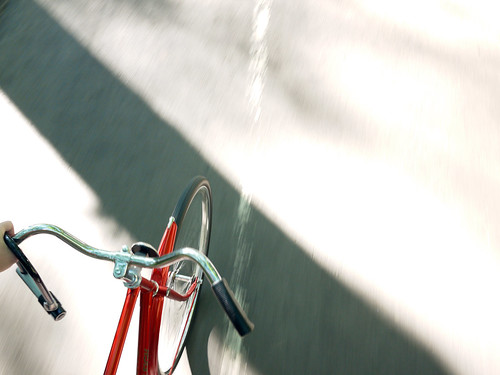
Riding bikes to the newly renamed Cooley Law School Stadium (nee Oldsmobile Park) is one of our favorite evenings in the area, and judging from the crowded bike racks this last Thursday, we're not alone. We were running a little late, so we couldn't stop for a bite at one of the many delicious places to eat in the area. If you have the chance, check out Geno's Pizza, Michigan Brewing Company, or the Spotted Dog Cafe on Washington in the downtown area.
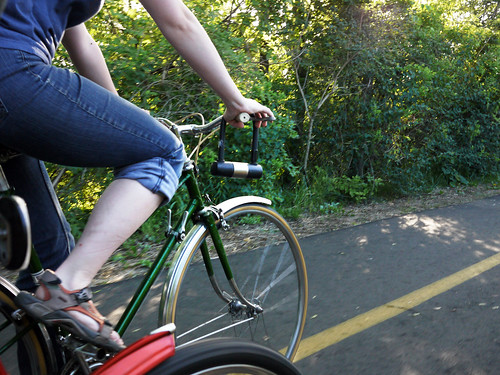
Luckily, the Rivertrail is in great shape right now, clear of flooding and well-maintained. We cruised along on our old Raleigh bikes, enjoying a leisurely sweatless ride in the humid heat.

It cooled off a bit as the sun went down and the Lugnuts battled to a loss extra innings. Still, it was another perfect Thirsty Thursday out in left field, and a great day to be in Lansing.
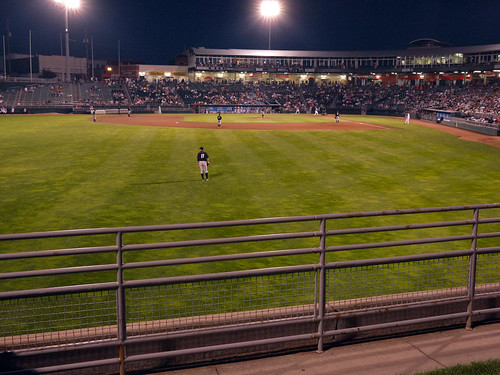
Tuesday, June 8, 2010
The case for wider tires
More than any other component, a tire change can radically change the ride of a bicycle. A good road tire can make a bike feel lively, smooth out road vibrations, and speed up the rider, all at the same time. In contrast with the usual skinny high-pressure tires that come standard on road bikes, my experience tells me wide tires with fine tread and light casing have the best combination of speed, smoothness, and roadfeel.
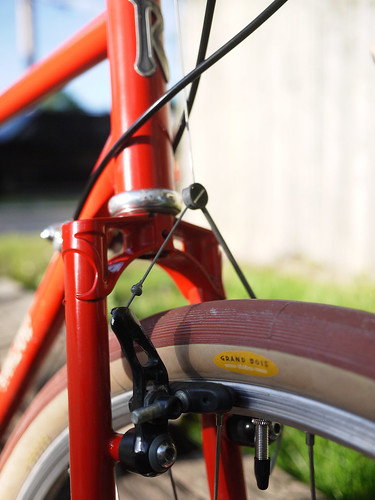
Today, most manufacturers design modern road bikes so they do not accept a tire wider than 700x25c, with tight brake and seatstay clearance that also precludes fender mounting. This is fine for a race bike (though I'd argue room for 28mm tires would be beneficial there too), but a 23mm wide tire is really not ideal for commuting or multi-day rides. Those shopping for a road bike with this in mind would do well to check out brands like Surly, who make steel frames with clearance for wider tires, and cyclocross bikes, which are designed to fit up to 700x35c tires and typically have cantilever brakes. Many older steel bikes did have more clearance for wide tires and fenders, and if you feel like it, a tight frame can get more clearance when converted to the 650b wheel size, which you can read about here.
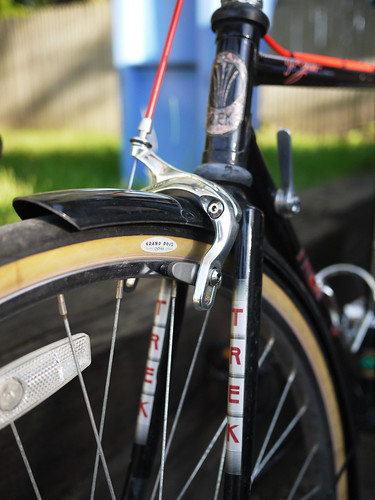
Even experienced cyclists will repeat the fallacy that skinny tires are faster than wide tires, but tests at Bicycle Quarterly have shown that on imperfect surfaces like, say, Lansing's roads, a well-made ~30mm tire is actually fastest. The reason for this is that the cyclist loses a fair amount of speed to the road vibration that occurs with these narrower tires. Above 30mm, tires typically cannot hold the high pressures that fast road riding requires and tires get heavier, and so speed again starts to fall off, but with an increase in plushness.

A high-quality tire at this width can ride like a dream, and some of the best come from Japan's Grand Bois. They specialize in the 650b wheel diameter, which falls about halfway between 26" and 700c wheels, which no major manufacturer that I can think of supports, but there has been a recent resurgence of interest in thanks in part to companies like Rivendell, Grand Bois, and many custom framebuilders. My wife has been riding on a 650b-converted Trek 560 shod with Grand Bois Cypres 30mm tires for a couple years now, and has nothing but positive things to say about them, and these tires are also available in a more conventional 700cx30 size. The 42mm wide Grand Bois Hetre tires have also proven to be a good combination of speed, comfort, and feel. My friends kid me that I'm riding my beach cruiser when I put the Hetres on my Rawland Sogn, but the tires feel and ride great, plain and simple.
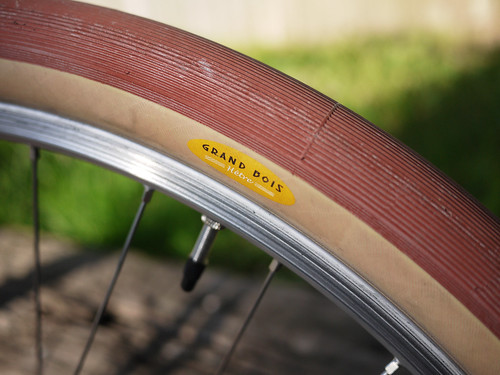
High-end tires like those made by Grand Bois and Challenge are not cheap, running at times well above $100 for a pair, and while folks have shown they are willing to shell out big bucks for a wheelset, pedals, and the like, tires are often a component that people feel they can spend less on. Panaracer's Pasela and Schwalbe's Marathon tires are some of the more moderately priced entries on the market and are available in a wide variety of sizes. These tires come in kevlar-belted varieties for puncture-protection, but in my experience these Kevlar belts actually produce a stiffer ride, and do not provide enough puncture protection to make the trade-off worthwhile.

Today, most manufacturers design modern road bikes so they do not accept a tire wider than 700x25c, with tight brake and seatstay clearance that also precludes fender mounting. This is fine for a race bike (though I'd argue room for 28mm tires would be beneficial there too), but a 23mm wide tire is really not ideal for commuting or multi-day rides. Those shopping for a road bike with this in mind would do well to check out brands like Surly, who make steel frames with clearance for wider tires, and cyclocross bikes, which are designed to fit up to 700x35c tires and typically have cantilever brakes. Many older steel bikes did have more clearance for wide tires and fenders, and if you feel like it, a tight frame can get more clearance when converted to the 650b wheel size, which you can read about here.

Even experienced cyclists will repeat the fallacy that skinny tires are faster than wide tires, but tests at Bicycle Quarterly have shown that on imperfect surfaces like, say, Lansing's roads, a well-made ~30mm tire is actually fastest. The reason for this is that the cyclist loses a fair amount of speed to the road vibration that occurs with these narrower tires. Above 30mm, tires typically cannot hold the high pressures that fast road riding requires and tires get heavier, and so speed again starts to fall off, but with an increase in plushness.

A high-quality tire at this width can ride like a dream, and some of the best come from Japan's Grand Bois. They specialize in the 650b wheel diameter, which falls about halfway between 26" and 700c wheels, which no major manufacturer that I can think of supports, but there has been a recent resurgence of interest in thanks in part to companies like Rivendell, Grand Bois, and many custom framebuilders. My wife has been riding on a 650b-converted Trek 560 shod with Grand Bois Cypres 30mm tires for a couple years now, and has nothing but positive things to say about them, and these tires are also available in a more conventional 700cx30 size. The 42mm wide Grand Bois Hetre tires have also proven to be a good combination of speed, comfort, and feel. My friends kid me that I'm riding my beach cruiser when I put the Hetres on my Rawland Sogn, but the tires feel and ride great, plain and simple.

High-end tires like those made by Grand Bois and Challenge are not cheap, running at times well above $100 for a pair, and while folks have shown they are willing to shell out big bucks for a wheelset, pedals, and the like, tires are often a component that people feel they can spend less on. Panaracer's Pasela and Schwalbe's Marathon tires are some of the more moderately priced entries on the market and are available in a wide variety of sizes. These tires come in kevlar-belted varieties for puncture-protection, but in my experience these Kevlar belts actually produce a stiffer ride, and do not provide enough puncture protection to make the trade-off worthwhile.
Thursday, May 27, 2010
Depth of Field: Don't Overdo It!

Taken with my Polaroid 110a at f/4.7
For good or bad, shallow depth of field is the attribute of a photograph that typically strikes a viewer as a quality of professional photography. It is also the subject I'm asked most about by lay photographers. I have seen many uses of shallow depth of field when it's inappropriate, and many budding photographers overuse the hell out of it once they figure out what it is, and how to produce it.
First, "depth of field" is a measure of how much of a photograph is in focus from near to far. Shallow depth of field is produced when the focus point is in focus, and that's about it, while deep depth is produced when essentially everything is in focus. It can be affected by many different things: lens aperture, lens focal length, isolation of subject from background, focal distance, and negative or sensor size.
Essentially, depth of field is at its shallowest when the subject is nearer to the camera, the aperture is set wider than say f/2.8, the lens is about 85e or longer, and the camera has a large negative size. Of these factors, one that seems to play a huge role is sensor or negative size; a large negative will always carry a shallower depth of field. This is why you can't get that background to go out of focus on your point and shoot digital camera, even with a wide open aperture. Really, if you want shallow depth of field, the simplest way to get it is to pick up a cheap 1970s mechanical film SLR with a 50mm f/1.8 lens, and go to town.

Sensor/negative size comparison chart
Aperture is important, sure, but a large negative size will prevail over a narrow aperture in many situations. My Polaroid SX-70 has an effective negative size of 3x3 inches, putting it squarely in medium format territory. Its maximum aperture is only f/8.8, but even as such it has a nice shallow depth of field in many situations:

As I mentioned earlier, shallow depth of field is easy to abuse once you know how to use it. If you want to isolate a subject from a background, it's wonderful; if you would like to take a photo of an object receding into the distance, not so much usually. It's also easy to overdo it at a certain point, where your subject is not necessarily entirely in focus, which can become distracting. You can also miss out on a lot of interesting background images if you become too obsessed with shallow depth of field. Finally, I tend to notice that modern lenses, with their ultra-sharp plane of focus, can produce rather ugly effects as focus falls off and the background becomes blurred.
Here are some of my favorites from others and myself:
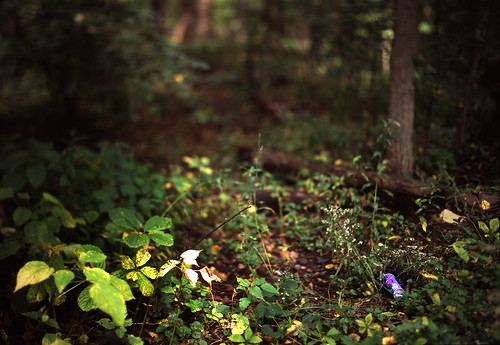
(Mine - Tilted film plane adds makes the depth even shallower )
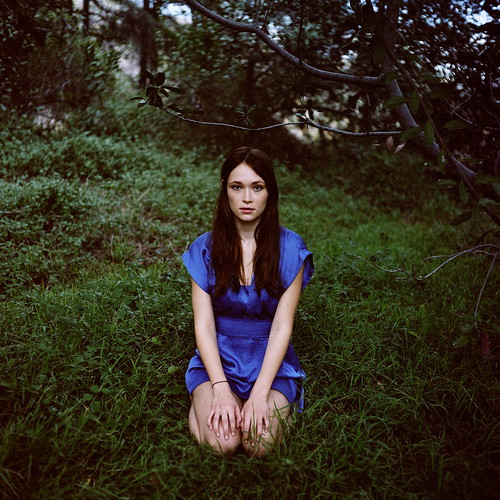
One of Lou O'Bedlam's many awesome portraits.
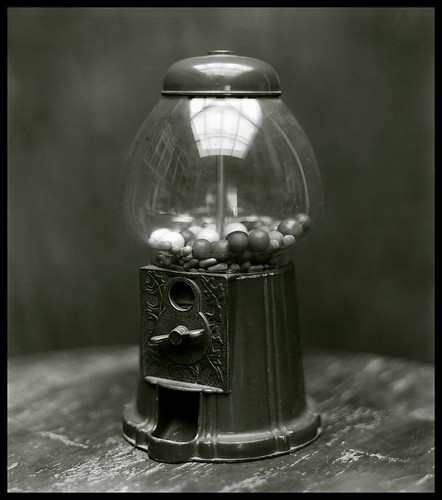
Some of my friend Andy's amazing work with the old Kodak Aero-Ektar lens.
Finally, though I don't show his work in this post, I also highly recommend checking out the photos of Jonathan Hillhouse. His depth of field usage is often incredible.
Sunday, May 23, 2010
Ride of Silence
This past Wednesday was the annual Ride of Silence in North America. If you're not familiar, the Ride of Silence is a slow group ride to remember those cyclists who have been injured or killed while cycling on public roadways. If you are interested in finding a ride near you for next year, check out this link.
I took along my Polaroid SX-70 and took some of the last 600 film I have access to.

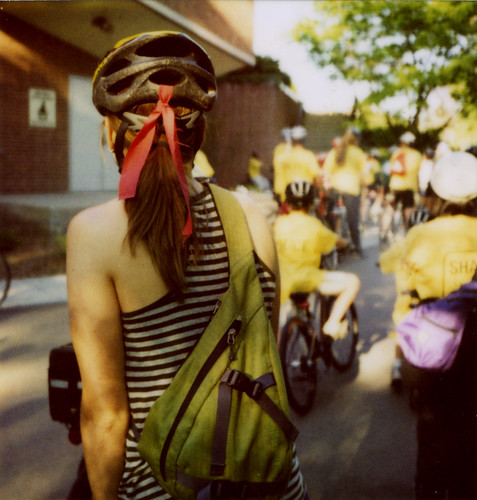
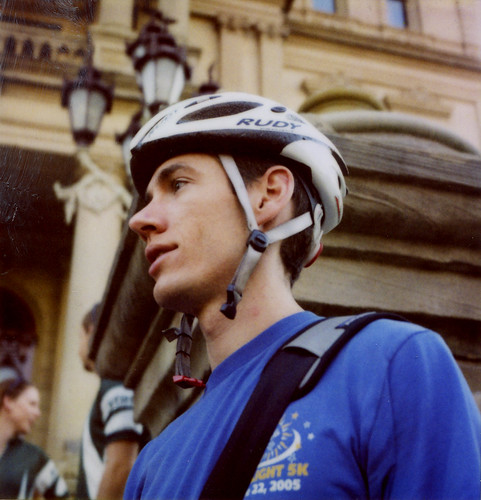
I took along my Polaroid SX-70 and took some of the last 600 film I have access to.



Tuesday, May 4, 2010
Happy Polaroid Week!
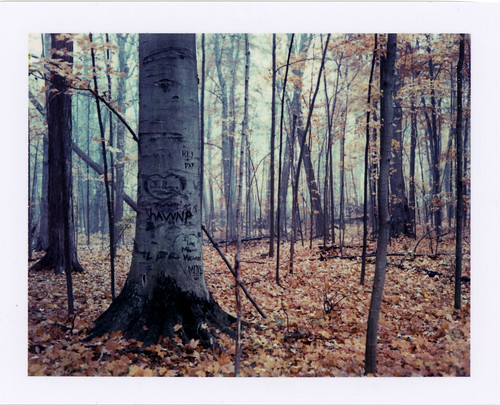
This Monday through Friday mark the spring Polaroid week on Flickr, where instant photographers post lots of incredible photos to a group pool to show how distinct and versatile that medium is. People always ask me, "What kind of camera is your favorite?" and my answer always has to be Polaroid, strange as that may seem. There are many reasons for this - my first real camera was a Polaroid SX-70, inherited from my grandfather. Also, I have many fond memories of Polaroids from my youth, when we would go fishing, or at a birthday party. When I got into film photography again, the Polaroid was there for me - easy to scan, instant results, and incredible colors.
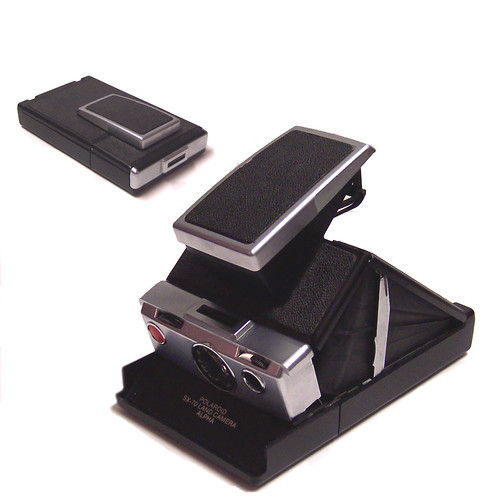
But more than that, Polaroid made some very interesting film and cameras. The SX-70 is in my opinion the greatest camera ever made. It's an SLR that folds completely flat and is easy to carry, has a great lens that focuses down to 10 inches, and for the first time a camera developed prints before your very eyes, in daylight no less. It has the ability to amaze everyone from children to ol pro photographers. The film has that unique Polaroid look to it, with faded colors, development abnormalities, and an overall glow. There are photoshop actions that mimic it, but nothing ever gets it quite right.

So whenever Polaroid week comes around, it reminds me to shoot up the remaining film stock that I have, and to enjoy those cameras once more. The film I love is gone for good - Polaroid quite making Time-Zero, 600, 669 and all the rest a couple years ago. Thankfully I can stock up on the equivalent Fuji films for my old packfilm warhorse, and for the SX-70, the Impossible Project is doing some remarkable work bringing new filmstocks to the market. I personally can't wait to try their black and white 600 version of the new Silver Shade films. \
Here are some of my favorite Lansing-themed Polaroids:
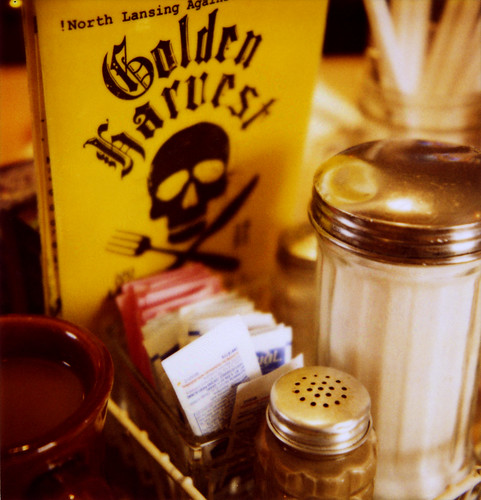
Golden Harvest
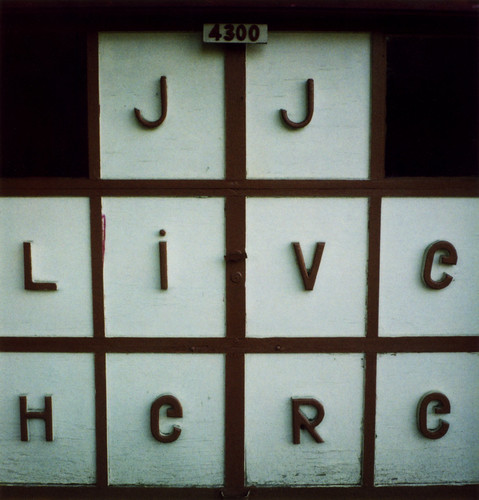
JJ Live Here
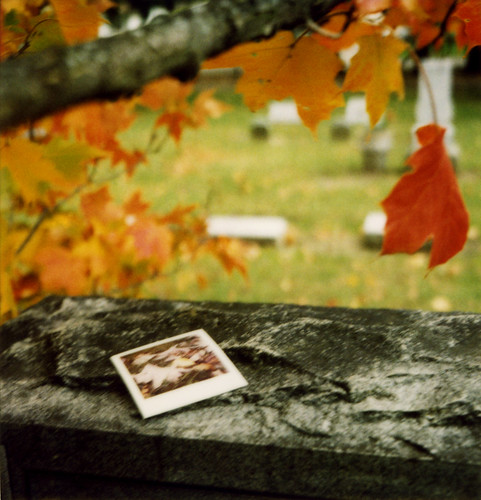
Mt Hope Cemetery
Monday, April 26, 2010
Lansing Tweed Ride

Get down with your dapper self and join us for a Trajet de Tweed around Lansing on Saturday May 1st at noon, departing from Lansing's Frandor Shopping center, specifically the skate park area. It'll be a short leisurely ride about town, with the option of further riding with the Healthy Lungs Ride at 1:30 pm to celebrate the smoke-free bar legislation, or just partake in some refreshing ale at a nearby pub. Contact Marci Baranski for more details.
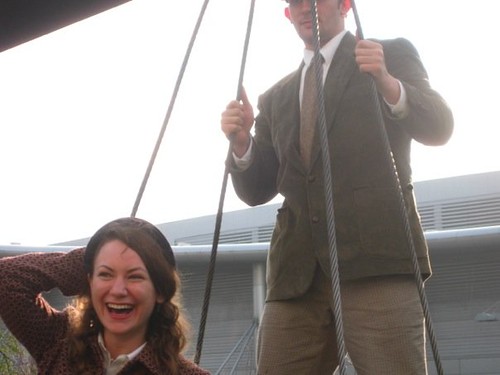
On an unrelated note, one of my friends was recently hit by a vehicle while riding his bike on campus. I don't know all the details yet, nor do I know if I should share them, but if you're driving around the area please be careful - there are beginning to be lots of bicyclists on the streets.
Wednesday, April 7, 2010
Time to make a change
There's this obsession with the newest, greatest equipment, whether it be the new $5000 Leica camera, the lightest wheelset for your bicycle, the fanciest steel lugs on a bike frame, or the quickest car around a track. Having functional equipment is certainly important, but taking things so seriously as to worry about the number of ounces of a crankset, whether all the components on a bike match, or the name on a camera? There comes a point when the emphasis on expensive gear takes on a condescending air, as if you need the best equipment to enjoy yourself. It also takes all the fun out of a hobby when you start to care about acquiring the latest gadget rather than riding your bike or taking photos. To a certain extent, I've fallen victim to it as well, getting excited about shiny bits for a bike, coveting a new lens that I'd probably in actuality never use.
![]()
For many, having inexpensive gear is a matter of necessity. If you don't have 2 nickels to scrape together, chances are pretty good you're not riding a Cervelo with a Leica M9 strapped around your neck, but that doesn't mean you can't enjoy a bike ride, or take some great photos. A recent post on a Ecovelo, a bicycle and photography blog that I have enjoyed, polled its readers to find out the maximum price they would spend on a bicycle used for commuting. The range in options, if you don't want to visit the site, was from $500 at the low end to $4000 at the high end. Ask the man on the street, and he'll tell you even $500 is a bit dear for a bike, let alone thousands of dollars, but from the comments on that post it seems there are plenty of people out there who think it's almost necessary to spend above $2000 to get a decent commuter bike. Many even wished for "no ceiling" as an option, which seems a little surprising.

If Contador were a photographer, he'd swing a Leica, guaranteed.
My commuter lately has been the Bridgestone XO-1, a bike that, with all the work and components, cost me a bit under $500, and I still worry about locking it up outside. The XO is an almost perfect metaphor for the pitfalls of our consumerist society - the magazines panned it because it didn't follow the set rules of the game at the time, so they sat on the shelves unbought for years. Now they're rare and chic again, and selling better than they ever did new. The bike rides great - it's comfortable, smooth, pretty, and fast enough for my needs. Looking around at my workplace, and at my commuting friends, I don't see a single person who rides an around-town bike that's worth in excess of $300-$400, let alone in the thousands of dollars. What exactly do we gain by spending $2000 or more on a bike to ride around town and run errands?
![]()
Parhaps you shouldn't mind spending money on quality, but is that what's for sale here? Most of the equipment the shops and magazines are selling will make little to no difference in your enjoyment of a hobby, and may be of poorer quality than what you are replacing. The Cupcakerator rides on an old Raleigh 3-speed around Chicago, and every once in a while she'll think that she wants a Pashley, or some other dutch bike. A Pashley, in all honesty, is not much nicer to ride or own than her Raleigh - both are big, heavy steel bikes, both have internal hubs for ease of drivetrain maintenance, both have that classic upright style. The Raleigh's brakes aren't quite as nice as the modern bike's but of course that's an easy and cheap fix. Why does she want a newer bike that costs well over a thousand dollars? "Because it has a curved top tube," she says, but I suspect it's also a bit of the consumerism that pulses through the hobby. To borrow some verbiage from BSNYC, you can be a beautiful Godzilla atop a dutch bike, a Fred on your way to the coffee shop clad in lycra and cleats, or a fixie-riding hipster in skinny jeans, but underneath all that highly stylized veneer they're all the same person. Spend all the money you want to buy a lifestyle, and you will still end up with only the illusion of one.
![]()
This bike is something to be scorned in today's society.
A friend brought me over to his place yesterday, and he was excited to show me his new bike. I looked quickly, and chuckled aloud when I saw it - a funky pseudo-mountain bike with a coaster brake, internal hub, and not much else - it's the kind of thing any "serious" biker would very much turn up his nose at. But looking closer, it had a nice set of touring tires on it, a 4-speed Shimano internally geared hub, and the frame wasn't all that heavy either, and besides, if he was excited and happy with it, who the hell am I to judge? I couldn't believe it when I heard it coming from my own mouth - the smug chuckle of vanity. His plan today is to take it on an ~80 mile ride with a friend, and that's something no cyclist should turn his nose up at.

Radiating Smugness
At best, this kind of attitude becomes a bit costly, and at worst, you turn into a connoisseur, a nice word for someone who hoards objects they desire for no practical reason. You get to the point where you look down on people who are actually using nice equipment instead of hanging it on a wall or displaying it in a museum. Before I get to that undesirable end, I'm going to start cutting off the offensive pieces of myself, Craigslist-style. This Bris of belongings will start with the most galling of extraneous objects, a fixed gear Fuji with Campagnolo components.
For many, having inexpensive gear is a matter of necessity. If you don't have 2 nickels to scrape together, chances are pretty good you're not riding a Cervelo with a Leica M9 strapped around your neck, but that doesn't mean you can't enjoy a bike ride, or take some great photos. A recent post on a Ecovelo, a bicycle and photography blog that I have enjoyed, polled its readers to find out the maximum price they would spend on a bicycle used for commuting. The range in options, if you don't want to visit the site, was from $500 at the low end to $4000 at the high end. Ask the man on the street, and he'll tell you even $500 is a bit dear for a bike, let alone thousands of dollars, but from the comments on that post it seems there are plenty of people out there who think it's almost necessary to spend above $2000 to get a decent commuter bike. Many even wished for "no ceiling" as an option, which seems a little surprising.

If Contador were a photographer, he'd swing a Leica, guaranteed.
My commuter lately has been the Bridgestone XO-1, a bike that, with all the work and components, cost me a bit under $500, and I still worry about locking it up outside. The XO is an almost perfect metaphor for the pitfalls of our consumerist society - the magazines panned it because it didn't follow the set rules of the game at the time, so they sat on the shelves unbought for years. Now they're rare and chic again, and selling better than they ever did new. The bike rides great - it's comfortable, smooth, pretty, and fast enough for my needs. Looking around at my workplace, and at my commuting friends, I don't see a single person who rides an around-town bike that's worth in excess of $300-$400, let alone in the thousands of dollars. What exactly do we gain by spending $2000 or more on a bike to ride around town and run errands?
Parhaps you shouldn't mind spending money on quality, but is that what's for sale here? Most of the equipment the shops and magazines are selling will make little to no difference in your enjoyment of a hobby, and may be of poorer quality than what you are replacing. The Cupcakerator rides on an old Raleigh 3-speed around Chicago, and every once in a while she'll think that she wants a Pashley, or some other dutch bike. A Pashley, in all honesty, is not much nicer to ride or own than her Raleigh - both are big, heavy steel bikes, both have internal hubs for ease of drivetrain maintenance, both have that classic upright style. The Raleigh's brakes aren't quite as nice as the modern bike's but of course that's an easy and cheap fix. Why does she want a newer bike that costs well over a thousand dollars? "Because it has a curved top tube," she says, but I suspect it's also a bit of the consumerism that pulses through the hobby. To borrow some verbiage from BSNYC, you can be a beautiful Godzilla atop a dutch bike, a Fred on your way to the coffee shop clad in lycra and cleats, or a fixie-riding hipster in skinny jeans, but underneath all that highly stylized veneer they're all the same person. Spend all the money you want to buy a lifestyle, and you will still end up with only the illusion of one.
This bike is something to be scorned in today's society.
A friend brought me over to his place yesterday, and he was excited to show me his new bike. I looked quickly, and chuckled aloud when I saw it - a funky pseudo-mountain bike with a coaster brake, internal hub, and not much else - it's the kind of thing any "serious" biker would very much turn up his nose at. But looking closer, it had a nice set of touring tires on it, a 4-speed Shimano internally geared hub, and the frame wasn't all that heavy either, and besides, if he was excited and happy with it, who the hell am I to judge? I couldn't believe it when I heard it coming from my own mouth - the smug chuckle of vanity. His plan today is to take it on an ~80 mile ride with a friend, and that's something no cyclist should turn his nose up at.

Radiating Smugness
At best, this kind of attitude becomes a bit costly, and at worst, you turn into a connoisseur, a nice word for someone who hoards objects they desire for no practical reason. You get to the point where you look down on people who are actually using nice equipment instead of hanging it on a wall or displaying it in a museum. Before I get to that undesirable end, I'm going to start cutting off the offensive pieces of myself, Craigslist-style. This Bris of belongings will start with the most galling of extraneous objects, a fixed gear Fuji with Campagnolo components.
Thursday, March 11, 2010
Developments in Cycling
Lots of new things have been going on in the world of cycling, but one of the most important recent events was the unveiling of Bike directions via Google Maps. Even more exciting, East Lansing and Lansing were on the initial rollout of the feature, which should be great for local bikers.
Let's say, for example, you're in Old Town's famous Golden Harvest restaurant, eating yourself a Bubba Sandwich. So tasty you forget that, holy crap, you gotta be to work at Bessey Hall all the way over on Michigan State campus in 40 minutes! Not that this has ever happened to me, of course. You wonder whether you'd have time to ride the Rivertrail, or should you instead take surface streets to get there faster? Well Google Maps will now tell you what route is best to bike - it recommends the Rivertrail - and it'll also tell you how long it would take to ride, taking different routes. In this case Saginaw to Michigan is a good 10 minutes faster, but I'd really recommend the Rivertrail route, or at least Kalamazoo, which has a bike lane. Good job, Google!

Locally, it's just about time for the season's first race, the Barry-Roubaix. If you want to dip your big toe in the world of bike racing, the Barry is a pretty good opportunity. It has levels of racing ranging from the beginner-friendly 23 mile lap to the extreme challenge of 2 laps, at 65 miles. It's raced pretty much entirely on gravel and a little on singletrack, so a fat-tired road bike is just about perfect (think cyclocross, 28mm or wider), but a mountain bike will do in a pinch of course. It's all happening on March 27th, in Middleville. You can buy tickets in advance, or register on the day of the race for an additional $10. Afterwards, there will be a big bonfire by the beach, so BYOB! I will probably be riding the Bridgestone XO-1, unless the mud or snow gets silly, in which case I'll try out the Rawland Sogn. Hopefully I can get some training rides in before the actual race...
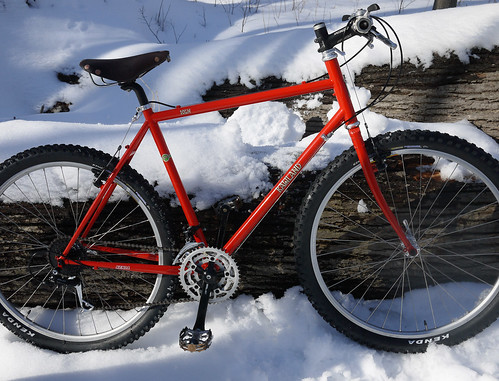
Let's say, for example, you're in Old Town's famous Golden Harvest restaurant, eating yourself a Bubba Sandwich. So tasty you forget that, holy crap, you gotta be to work at Bessey Hall all the way over on Michigan State campus in 40 minutes! Not that this has ever happened to me, of course. You wonder whether you'd have time to ride the Rivertrail, or should you instead take surface streets to get there faster? Well Google Maps will now tell you what route is best to bike - it recommends the Rivertrail - and it'll also tell you how long it would take to ride, taking different routes. In this case Saginaw to Michigan is a good 10 minutes faster, but I'd really recommend the Rivertrail route, or at least Kalamazoo, which has a bike lane. Good job, Google!

Locally, it's just about time for the season's first race, the Barry-Roubaix. If you want to dip your big toe in the world of bike racing, the Barry is a pretty good opportunity. It has levels of racing ranging from the beginner-friendly 23 mile lap to the extreme challenge of 2 laps, at 65 miles. It's raced pretty much entirely on gravel and a little on singletrack, so a fat-tired road bike is just about perfect (think cyclocross, 28mm or wider), but a mountain bike will do in a pinch of course. It's all happening on March 27th, in Middleville. You can buy tickets in advance, or register on the day of the race for an additional $10. Afterwards, there will be a big bonfire by the beach, so BYOB! I will probably be riding the Bridgestone XO-1, unless the mud or snow gets silly, in which case I'll try out the Rawland Sogn. Hopefully I can get some training rides in before the actual race...

Sunday, February 28, 2010
More Snow...
Last day of February, and unless we get a few more inches today (it's forecasting for some light snow tonight), this month will go in the books with just more than 20 inches of the stuff, more than double our average. I don't mind riding in the snow too much, but driving on the expressways to clinical sites hours away has gotten tiring. And shoveling the driveway has gotten very tedious to say the least. Enjoy these photos of the snow, hopefully we'll have some signs of life from spring soon. I'm not holding my breath though.

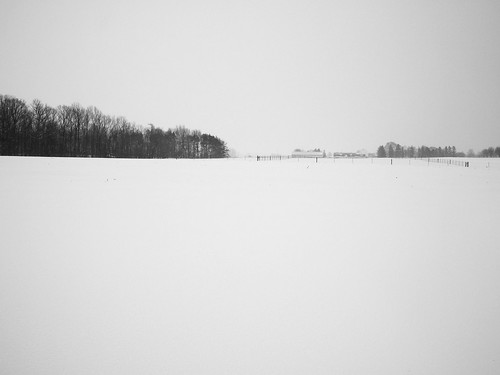
(If you don't remember what April was like last year):
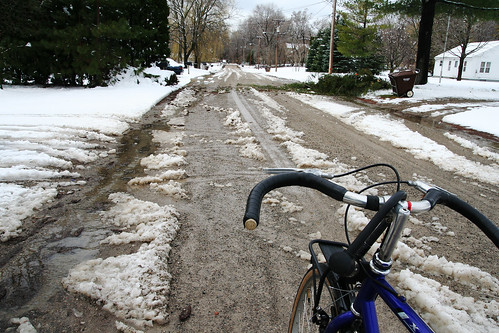


(If you don't remember what April was like last year):

Tuesday, February 23, 2010
New Job!
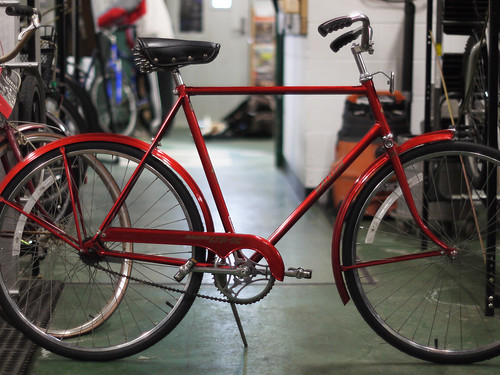
Technically I've been working there for a couple months, but I haven't mentioned it here. I'm working at the Michigan State University's Bike Shop on campus as a mechanic. It's a bunch of fun, learning about how to polish and fix up old and rusty frames and make them usable, if not beautiful in many cases. We operate a cool rental bike unit, where students and faculty can rent bikes for unreasonably low rates, and have them serviced by us for free. It's a great service, and it's nice to see how well-used it is on campus. Many of these bikes are abandoned at the end of the semester, and the Bike Shop gets to pick over the pile that the police impounds for rentals.

We also accept donations from folks, which we either turn into rentals or sell to support the store. Some people have gifted MSU Bikes some incredibly beautiful bikes, Like a Bianchi track frame that was entirely unridden, a Tommasini road frame (also unridden), many cool three-speeds, and most recently a Peugeot PX-10 that needed a lot of work, but has turned out very well:


Finally, we do repairs, sell parts and accessories, and generally try to support the campus bike community in activism, get-togethers, races, or whatever else on two wheels that might be going on locally. If you've yet to check it out, go down to Bessey Hall on campus - the shop is on the riverfront side. It's a great resource run by caring people.
Thursday, February 11, 2010
Can I ride in the wintertime?
If you live and work in Lansing or East Lansing, you've probably got pretty decent bicycling routes, and the roads are usually clear enough to ride in. Roads like Farm Lane, Forest, and other lightly traveled roads are a joy to ride on, and you can't beat the scenery. But even a dedicated summertime cyclist will sometimes balk at the idea of going out in any weather below 40 degrees, which doesn't make any real sense to me.
So why not ride in the winter? Here are some common things I hear.
1) It's too cold out!
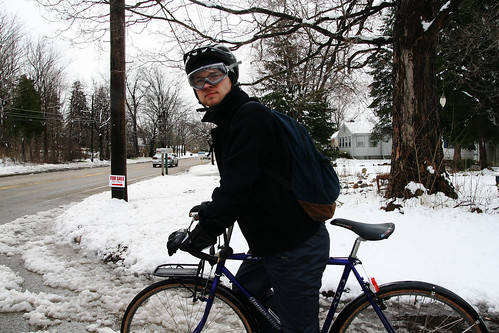
Have you ever noticed that you can get hot and sweaty while exercising? Believe me, this is true on a bicycle, even in the winter. Sometimes especially in the winter. If you layer your clothing, you'll never be cold except for maybe the first minute you walk out the door. It's a lot warmer than walking to and from the car in a parking lot, because of the heat your body is putting out from all that aerobic exercise.
You don't need to spend a ton of money on winter cycling gear either. I usually wear a pair of long underwear on the bottom with jeans over top, hiking boots over wool socks, a long-sleeved wool shirt or sweater, gloves with glove liners, and some sort of ear warmers. On the very coldest days, you might need full face protection like a balaclava, but really I've only found that necessary in temps below 15 degrees, or in a lot of wind. The local Playmakers store has some awesome Smartwool gear that I swear by - the light wool wicks sweat, never smells bad, and looks good.
2) It's too icy out!
It rarely is. In Michigan, the streets are cleared pretty quickly in main travel areas of any deep snow, and if it's safe for a car to travel on, then it's safe enough for a bike. Bikes have narrow tires that cut through slush and light snow pretty well, and a set of knobby tires makes things even easier.
As for ice, I don't really run into it very much, and the few times I do, nothing bad comes of it. Just slow down around turns, walk the bike across railroad crossings, and Bob's your uncle. If ice really scares you, there are plenty of studded tires on the market made specifically for riding on ice, or you can even make your own. Personally I've not fallen due to icy conditions (knock on wood), and I ride on regular knobby mountain bike tires.
Lots of people make the mistake of riding on the shoulder or sidewalk, which are rarely cleared enough to ride in. Just invest in some lights, ride in the cleared sections (yes, on the road), and you'll find it's a lot easier to stay upright. The road is actually quite a bit safer to ride on than the sidewalks, but that's a whole other blog post.
3) I don't have the right equipment!
You might actually. Winter biking doesn't take a fancy bike or clothing, you can do it pretty cheaply. I bought a used cheap mountain bike at the MSU Surplus Store for $15. It needed a new front wheel, chain, and a tune-up, but even with all that work and parts it was less than $100. If doing tune-ups isn't your thing, then you could pop over to MSU's Bike Shop and spring for a freshly tuned used bike, or even rent one for a season cheaply. (Disclaimer: I work at the Bike Shop)
If you are serious about commuting, you'll want a set of fenders for your bike to keep the snow from jamming up your components and messing up your clothes. An absolute MUST HAVE is a decent set of front and rear lights, and you should run them day and night for visibility. I prefer Planet Bike's Superflash for the rear, and for the front their new Blaze 2 watt. A blinky mode with a bright LED light helps cars see you for safety, but the cold can drain batteries quickly, so bring an extra set of batteries just in case. Lights seem to be getting better every year, and cheaper too.
4) I still think you're crazy...
Well, I'm not. Winter cycling is a great way to get yourself outside and exercising in these cold bleak months, and it really doesn't take a silly amount of money or expertise to do it. Just invest in some lights, get your bike set up, and wear some layers. For maintenance, the most important thing is to keep your chain well-lubed on a weekly basis with a heavier grade of lube, like Pedro's Syn Lube.
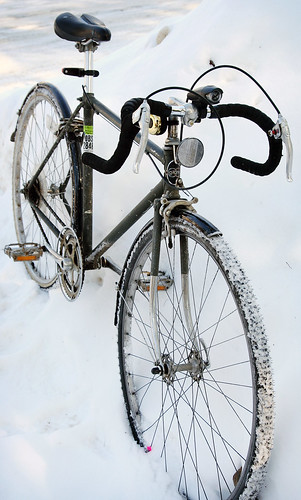
If you decide winter commuting or riding is for you after trying it, you can spring for some accessories to make your ride easier:
- Goggles - nice to have for rainy or windy days. Buy a cheap set of snowboarding or even lab goggles.
- Rear rack and Panniers - I have a set of waterproof Ortlieb Panniers, and they're incredibly useful. Gets the load off your back, and holds a ton of stuff in a waterproof environment.
- Studded tires - as mentioned above, they're not truly necessary, and they're expensive, but some people swear by them. They can't hurt.
So give it a try, and maybe you'll like it. I do - it gets me outside, gives a good workout, and saves a lot of money on gas and parking fees, especially on MSU's campus.
So why not ride in the winter? Here are some common things I hear.
1) It's too cold out!

Have you ever noticed that you can get hot and sweaty while exercising? Believe me, this is true on a bicycle, even in the winter. Sometimes especially in the winter. If you layer your clothing, you'll never be cold except for maybe the first minute you walk out the door. It's a lot warmer than walking to and from the car in a parking lot, because of the heat your body is putting out from all that aerobic exercise.
You don't need to spend a ton of money on winter cycling gear either. I usually wear a pair of long underwear on the bottom with jeans over top, hiking boots over wool socks, a long-sleeved wool shirt or sweater, gloves with glove liners, and some sort of ear warmers. On the very coldest days, you might need full face protection like a balaclava, but really I've only found that necessary in temps below 15 degrees, or in a lot of wind. The local Playmakers store has some awesome Smartwool gear that I swear by - the light wool wicks sweat, never smells bad, and looks good.
2) It's too icy out!
It rarely is. In Michigan, the streets are cleared pretty quickly in main travel areas of any deep snow, and if it's safe for a car to travel on, then it's safe enough for a bike. Bikes have narrow tires that cut through slush and light snow pretty well, and a set of knobby tires makes things even easier.
As for ice, I don't really run into it very much, and the few times I do, nothing bad comes of it. Just slow down around turns, walk the bike across railroad crossings, and Bob's your uncle. If ice really scares you, there are plenty of studded tires on the market made specifically for riding on ice, or you can even make your own. Personally I've not fallen due to icy conditions (knock on wood), and I ride on regular knobby mountain bike tires.
Lots of people make the mistake of riding on the shoulder or sidewalk, which are rarely cleared enough to ride in. Just invest in some lights, ride in the cleared sections (yes, on the road), and you'll find it's a lot easier to stay upright. The road is actually quite a bit safer to ride on than the sidewalks, but that's a whole other blog post.
3) I don't have the right equipment!
You might actually. Winter biking doesn't take a fancy bike or clothing, you can do it pretty cheaply. I bought a used cheap mountain bike at the MSU Surplus Store for $15. It needed a new front wheel, chain, and a tune-up, but even with all that work and parts it was less than $100. If doing tune-ups isn't your thing, then you could pop over to MSU's Bike Shop and spring for a freshly tuned used bike, or even rent one for a season cheaply. (Disclaimer: I work at the Bike Shop)
If you are serious about commuting, you'll want a set of fenders for your bike to keep the snow from jamming up your components and messing up your clothes. An absolute MUST HAVE is a decent set of front and rear lights, and you should run them day and night for visibility. I prefer Planet Bike's Superflash for the rear, and for the front their new Blaze 2 watt. A blinky mode with a bright LED light helps cars see you for safety, but the cold can drain batteries quickly, so bring an extra set of batteries just in case. Lights seem to be getting better every year, and cheaper too.
4) I still think you're crazy...
Well, I'm not. Winter cycling is a great way to get yourself outside and exercising in these cold bleak months, and it really doesn't take a silly amount of money or expertise to do it. Just invest in some lights, get your bike set up, and wear some layers. For maintenance, the most important thing is to keep your chain well-lubed on a weekly basis with a heavier grade of lube, like Pedro's Syn Lube.

If you decide winter commuting or riding is for you after trying it, you can spring for some accessories to make your ride easier:
- Goggles - nice to have for rainy or windy days. Buy a cheap set of snowboarding or even lab goggles.
- Rear rack and Panniers - I have a set of waterproof Ortlieb Panniers, and they're incredibly useful. Gets the load off your back, and holds a ton of stuff in a waterproof environment.
- Studded tires - as mentioned above, they're not truly necessary, and they're expensive, but some people swear by them. They can't hurt.
So give it a try, and maybe you'll like it. I do - it gets me outside, gives a good workout, and saves a lot of money on gas and parking fees, especially on MSU's campus.
Thursday, January 28, 2010
New Issue Out
The commute has gotten extra wintery this week - it's about 13 degrees outside this morning, and a wind of 15 mph is coming out of the West. Luckily, I was headed East this morning, but that still leaves the ride home. I've found so far that the cold is never really a big deal, but that wind can just cut right through my gloves. Another couple tips - batteries go dead extra quickly, so bring a couple extra pairs if you're running lights (which you should be!), and water bottles, especially metal ones, can freeze pretty quickly.
In other news, the new issue of Dreamboat cyclist should be just hitting the news stands today. This one looks like it focuses on the new fusion of skeet shooting and cyclocross, or summer duathlon. Personally, I'll be buying my copy just to get that sweet poster of Mike Woods holding a chicken.
![]()
In other news, the new issue of Dreamboat cyclist should be just hitting the news stands today. This one looks like it focuses on the new fusion of skeet shooting and cyclocross, or summer duathlon. Personally, I'll be buying my copy just to get that sweet poster of Mike Woods holding a chicken.
Tuesday, January 26, 2010
Chilly Commute in Photos
Black and white goes well with the weather around here. In my photography, especially digital, I've found that I prefer black and white photos in places where color doesn't really matter all that much. Snow, portraits, and architecture are all examples of subjects where the lighting and composition matter much more than a bright showy splash of color. There are, of course, exceptions to the rule - bright red berries poking through the snow surely wouldn't be very picturesque without color. My commute has been mostly colorless lately, and I pass few fellow bikers on the road as well. It's a nice peaceful time to be out, and before you ask, I'm pretty rarely cold - about 10 minutes into the ride I'm already unzipping the jacket because I'm overheating.
Lots of friends think Holly and I are nuts to be out biking this time of year, but in many ways, this is the best time of year to be out. If I wasn't biking, I know I wouldn't have the gumption to be out in the cold just to take photos. But being outside, getting some fresh air, and not noticing the chill so much - these are all great reasons to head out, even on some of the worst days.
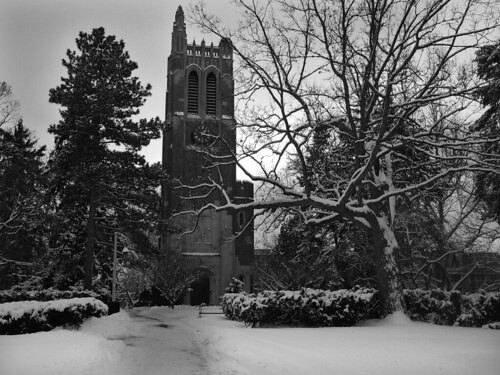
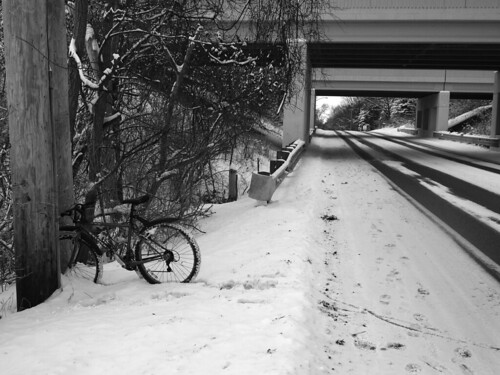
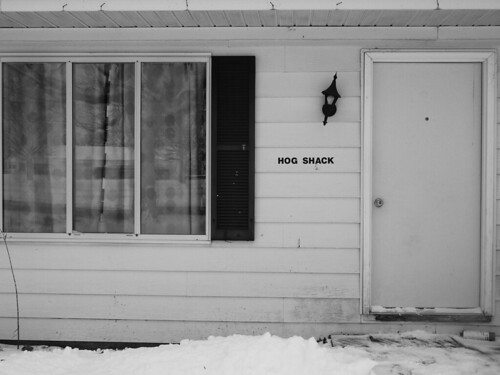
Lots of friends think Holly and I are nuts to be out biking this time of year, but in many ways, this is the best time of year to be out. If I wasn't biking, I know I wouldn't have the gumption to be out in the cold just to take photos. But being outside, getting some fresh air, and not noticing the chill so much - these are all great reasons to head out, even on some of the worst days.



Subscribe to:
Comments (Atom)

